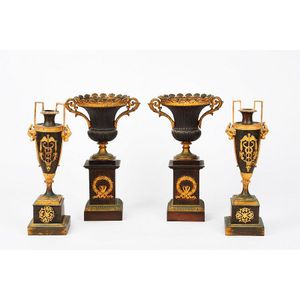Bronze-Inserted Slate Edwardian Comports/Clock Garnitures (26cm)
You must be a subscriber, and be logged in to view price and dealer details.
Subscribe Now to view actual auction price for this item
When you subscribe, you have the option of setting the currency in which to display prices to $Au, $US, $NZ or Stg.
- Edwardian - The Edwardian period of English furniture and decorative arts design is named for Edward VII (1841 ? 1910) who was King of the United Kingdom and the British Dominions and Emperor of India for the brief period from 1901 until his death in 1910. It follows the Victorian period, in turn was followed by the Art Nouveau and Art Deco styles. In Australia, designs of this period are also known as being in the Federation style.
- Bronze - An alloy of copper and tin, traditionally in the proportions of about 9 parts of copper to 1 part of tin.
The discovery of bronze in Western Asia in the 4th century enabled people to create metal objects which were superior to those previoulsy possible because of its strength and hardness, and it has been used throughout the world for weapons, coins, tools, statuary and other decorative items.
It is very fluid in a molten state, and its hardness, strength when set, and non-corrosive properties makes it most suitable for casting sculpture.
This item has been included into following indexes:
Visually similar items

A pair of gilt bronze table lamps, French 19th century, 62 cm high

Two pairs of ormolu mounted and patinated spelter Garnitures, 19th century, each cast as a double handled urn on pedestal base (4), approx. height 29 cm. Provenance: The Estate of Lady Gabriella Brenner, Bellevue Hill, NSW

A fine George III Scottish mahogany longcase clock, early 19th century, with maker's mark for Alexander Leith, the eight day movement clock with a broken swan neck pediment above an arched glass case flanked by pillars to a long cabinet with a shaped door

A George III mahogany two train long case clock, circa 1780, having a dome topped hood surmounted by brass finials, flanked by brass inlaid fluted columns, eight day movement chiming on a bell, the dial with applied silvered chapter ring bearing Roman nume
